For beginner perfume making, you'll want to start with safe dilution ratios between 15-25% essential oils to carrier oil. Use a 2% dilution (2 drops per teaspoon) for sensitive skin, or up to 10% for regular daily wear. Follow the classic perfume ratio of 50% base notes, 30% heart notes, and 20% top notes when blending. Choose carrier oils like jojoba or sweet almond to complement your scents. These fundamental ratios form just the foundation of crafting your signature fragrance.
Understanding Basic Perfume Dilution Percentages
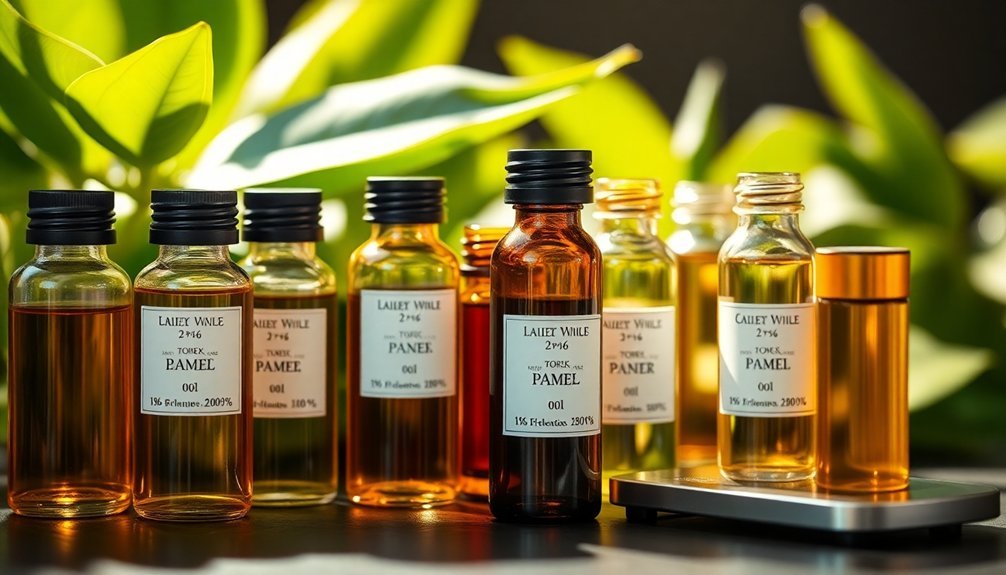
Three key percentages form the foundation of perfume dilution: 2%, 10%, and 20%.
When you're starting your perfume-making journey, understanding these ratios is vital for safe use. A 2% dilution serves as your baseline for topical applications, requiring just two drops of essential oil per teaspoon of carrier oil.
You'll find that 10% offers a balanced middle ground for everyday perfumes, while 20% creates a stronger scent that's still skin-safe.
Your essential oil dilution chart should reflect these standards: lighter dilutions for sensitive skin and daily wear, with stronger concentrations reserved for specific applications.
Keep essential oil dilutions light for everyday use; stronger blends should be used sparingly and for special purposes only.
For a typical 5ml perfume bottle, you'll want to combine 20 drops of fragrance oils with 80 drops of carrier oil to achieve a 20% blend that's both effective and safe.
Essential Oil Safety Thresholds for Personal Fragrances
When crafting personal fragrances with essential oils, you'll need to stay within specific safety thresholds to protect your skin. For daily wear, you can safely dilute your essential oils between 15-25%, though it's best to start at 10% for sensitive skin.
| Oil Type | Max Dilution Rate | Usage Notes |
|---|---|---|
| Regular Oils | 15-25% | Standard perfume use |
| Sensitive Oils | 10% | Daily wear recommended |
| High-Risk Oils | 0.07% | For oils like cinnamon bark |
When working with citrus oils, you'll want to use lower concentrations due to potential photosensitivity. For body care products, never exceed 2% essential oils in your total formulation. Remember to research each oil's specific safety limits, as they vary considerably between different types. Your safety depends on following these established dilution guidelines.
Measuring and Mixing Tools for Accurate Dilution
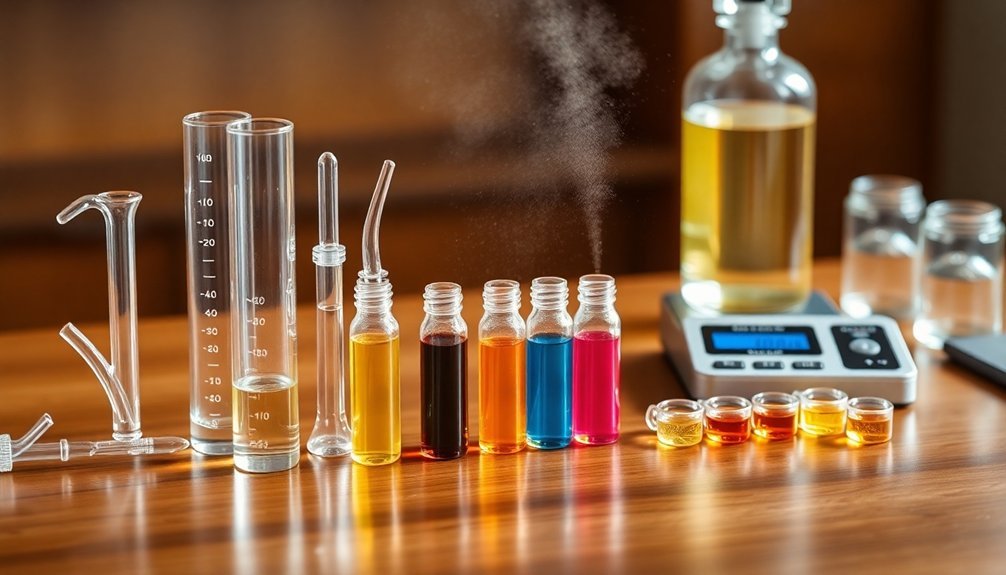
Accurate measurements make all the difference in perfume creation, so you'll need the right tools to achieve consistent results.
Precision is key in perfumery – having the right measuring tools ensures your fragrance blends turn out perfectly every time.
Start by equipping yourself with graduated pipettes and beakers for precise measuring of both essential oils and carrier oils.
A digital scale with a tare function is essential when working with small quantities. You'll want to weigh your ingredients in grams for the most accurate dilution ratios.
Don't forget to reset the scale between additions to maintain precision.
Track every measurement in a detailed notebook, recording the exact weights and ratios of each essential oil you use. This documentation will prove invaluable when you want to recreate successful blends.
For additional support, use a dilution calculator to determine the proper number of drops needed based on your bottle size and desired concentration.
Base, Heart, and Top Note Concentration Ratios
When crafting your perfume, you'll want to follow the classic 50-30-20 ratio: base notes at 50%, heart notes at 30%, and top notes at 20% of your total blend.
For a practical starting point, try using 10 drops of base notes, 5 drops of heart notes, and 5 drops of top notes in a 5ml bottle to achieve a balanced fragrance profile.
Your goal is to create a harmonious scent that shifts smoothly from the initial top notes through the heart, finally settling into the lasting base notes that will define your signature scent.
Optimal Base-Heart-Top Proportions
The foundation of successful perfume creation lies in understanding the delicate balance between base, heart, and top notes.
You'll want to start with your base notes, which should comprise 50-80% of your blend to guarantee a lasting foundation. This substantial proportion creates the deep, rich undertones that'll anchor your fragrance.
For your heart notes, a dilution is recommended at 20-40% of the total composition. These middle notes bridge your scent's foundation and its initial impression.
The remaining 10-30% should be reserved for top notes, which provide the first burst of fragrance upon application.
While a 50-30-20 ratio (base-heart-top) offers a reliable starting point, you can adjust these proportions based on your preferred scent profile and the specific essential oils you're using.
Essential Oil Blending Ratios
Making sense of essential oil blending ratios becomes easier when you break them down into precise measurements. When blending essential oils, you'll want to follow these key proportions for a balanced fragrance:
| Note Type | Percentage | Typical Oils |
|---|---|---|
| Base | 50-80% | Sandalwood, Vanilla |
| Heart | 20-40% | Jasmine, Rose |
| Top | 10-30% | Bergamot, Citrus |
For a beginner-friendly 5ml blend, start with 10 drops of base notes, 5 drops of heart notes, and 5 drops of top notes. Then, add your carrier oils to complete the formulation. This simple 10-5-5 ratio guarantees you're maintaining proper proportions while learning the art of perfumery. Remember that these percentages create the foundation for a well-balanced fragrance that evolves beautifully over time.
Perfume Note Balance Guide
Successfully crafting a balanced perfume requires understanding the three-tiered concentration system of fragrance notes.
When you use essential oils, start with your base notes, which should make up 50% of your blend. Add drops of essential oil like vanilla or sandalwood to create a strong foundation that'll provide lasting depth to your fragrance.
Next, incorporate heart notes at 30% of your composition. These middle notes, often featuring floral essential oils like jasmine or rose, form the core character of your perfume.
Finally, complete your blend with 20% top notes, using citrus or mint oils for that initial burst of fragrance.
Following this 50-30-20 ratio guarantees your perfume maintains a harmonious balance while developing properly on your skin throughout the day.
Carrier Oil Selection and Blending Mathematics
You'll master perfume-making by understanding two essential components: precise oil ratios and carrier oil selection.
Your choice of carrier oil, whether it's lightweight grapeseed or rich jojoba, directly impacts how your fragrance develops and performs on the skin.
Starting with a basic 20% fragrance to 80% carrier oil ratio will help you create balanced scents while learning the mathematical foundations of blending.
Calculating Perfect Oil Ratios
Creating the perfect perfume blend hinges on three essential calculations: your total dilution ratio, individual note proportions, and carrier oil measurements.
When crafting your signature scent, you'll need to maintain a safe dilution between 15-25% essential oils for perfumes.
- Calculate your total oil volume by multiplying the bottle size by your desired dilution percentage
- Use approximately 20 drops per milliliter when converting measurements
- Follow the 10-5-5 rule for a 5ml blend: 10 drops base, 5 drops heart, 5 drops head notes
- Add carrier oils like jojoba or sweet almond to complete your blend
- Always perform a patch test before full application
To guarantee accuracy, convert all measurements to drops, and don't forget that proper dilution with carrier oils isn't just about safety—it's vital for achieving the perfect scent balance.
Natural Carrier Oil Benefits
Three core factors make carrier oils indispensable in perfume creation: safety, scent stability, and skin nourishment. When you're working with essential oils, proper dilution in carrier oils guarantees safe topical application while maintaining the fragrance's integrity.
| Carrier Oil | Best For | Key Benefit |
|---|---|---|
| Jojoba | All Skin Types | Mimics Natural Oils |
| Sweet Almond | Sensitive Skin | Rich in Vitamin E |
| Grapeseed | Oily Skin | Light, Non-greasy |
You'll want to follow the 2% dilution rule: two drops of essential oils per teaspoon of carrier oil. Before applying your blend, always perform a patch test to check for sensitivities. Each carrier oil brings unique properties – jojoba's excellent for massage blends, while grapeseed works wonderfully for facial applications. Choose based on your skin type and intended use.
Blending Mathematics Made Simple
Understanding perfume blending mathematics builds directly on our carrier oil knowledge, transforming basic ingredients into precisely measured fragrances.
When you're diluting essential oils, you'll need to maintain specific ratios for both safety and ideal scent projection.
- Start with a 15-25% dilution ratio for perfumes, adjusting based on your sensitivity level.
- Calculate 12 drops of essential oils per ounce of carrier oil for a standard 2% dilution.
- Choose your carrier oils wisely – fractionated coconut oil works well for its neutral scent.
- Consider jojoba or sweet almond oil when you need additional moisturizing benefits.
- Always test your mathematical calculations with a small patch test before creating larger batches.
Remember to keep track of your measurements carefully, as precise ratios guarantee both safety and consistent fragrance quality in your final blend.
Creating Test Batches With Different Concentrations
The process of developing your signature perfume blend begins with small test batches at varying concentrations.
Start with a 20% essential oils ratio for your first test, which provides a strong foundation to adjust from. You'll want to use the drop method – combine 10 drops of base note, 5 drops of heart note, and 5 drops of head note in a 5ml bottle to guarantee it's safe to use and easy to replicate.
Keep detailed records of each batch by labeling the concentration percentage and scent profile.
Using small 1ml or 5ml bottles lets you experiment efficiently without wasting materials. Remember that 2 drops of essential oil per teaspoon of carrier oil equals a 2% dilution.
Once you've created your test batches, let them rest for a week before evaluating the final scent.
Scaling Recipes From Sample Size to Full Production
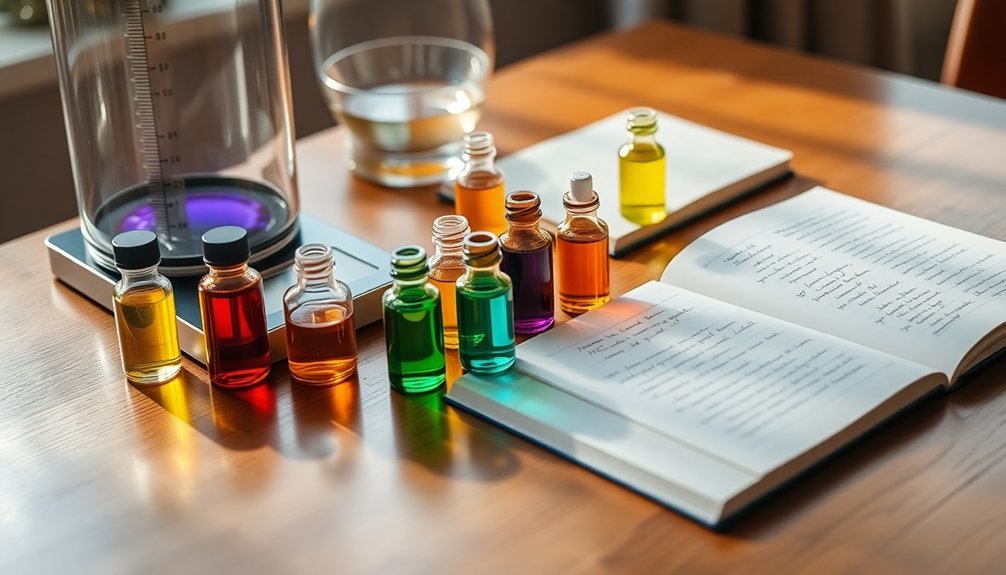
Once you've perfected your test batch formulation, scaling up to larger quantities requires precise calculations to maintain the integrity of your fragrance.
You'll need to carefully track the number of drops of essential oil per ounce to maintain the recommended 2% dilution ratio. Never use undiluted essential oils, as this can compromise safety and scent quality.
Essential oils require precise dilution – follow the 2% ratio and measure drops carefully to ensure both safety and fragrance excellence.
- Use an essential oil calculator to determine exact measurements for larger batches
- Document all ingredient adjustments to guarantee consistency across different scales
- Consider the varying potency levels of different essential oils when scaling up
- Test the scaled recipe before committing to full production
- Keep detailed records of your calculations and changes for future reference
Remember to verify your scent profile at each new scale to confirm your fragrance maintains its intended characteristics throughout the production process.
Frequently Asked Questions
What Is the 30/50/20 Rule for Essential Oils?
You'll blend essential oils using the 30/50/20 rule: 30% base notes for lasting foundation, 50% heart notes for main fragrance, and 20% head notes for initial scent, creating a well-balanced aromatic composition.
How Much Should Fragrance Oil Be Diluted?
You'll want to dilute fragrance oils between 15-25% for perfumes. For body care products, keep it at 2-5%. If you're using sensitive oils, stay under 10% and always test small amounts first.
What Is the 30/50/20 Rule for Perfume?
You'll create balanced perfumes by following the 30/50/20 rule: use 30% base notes (like vanilla), 50% heart notes (like florals), and 20% head notes (like citrus) in your fragrance composition.
What Is the Dilution Ratio for Perfume?
You'll want to use a dilution ratio between 15-25% for perfumes, meaning 15-25 parts fragrance oil to 75-85 parts carrier oil. For everyday wear, you can opt for a milder 10% dilution.
In Summary
You've now got the essential knowledge to safely dilute and blend your own perfumes. Start with small test batches at conservative ratios, keeping detailed notes of your measurements. Don't rush the process – take time to understand how different concentrations affect your final fragrance. As you gain confidence, you'll develop an intuitive sense for balancing oils while maintaining safety standards in your perfume creations.
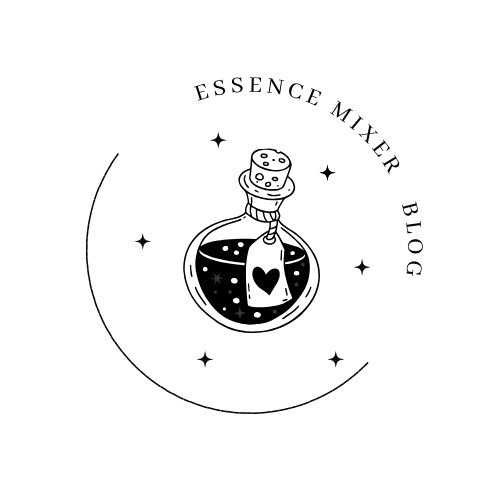
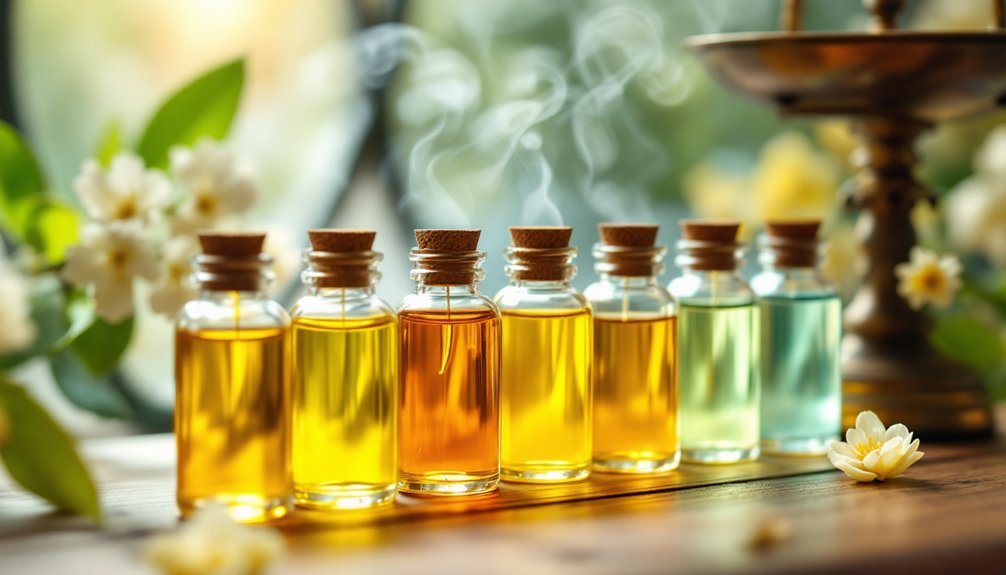



Leave a Reply